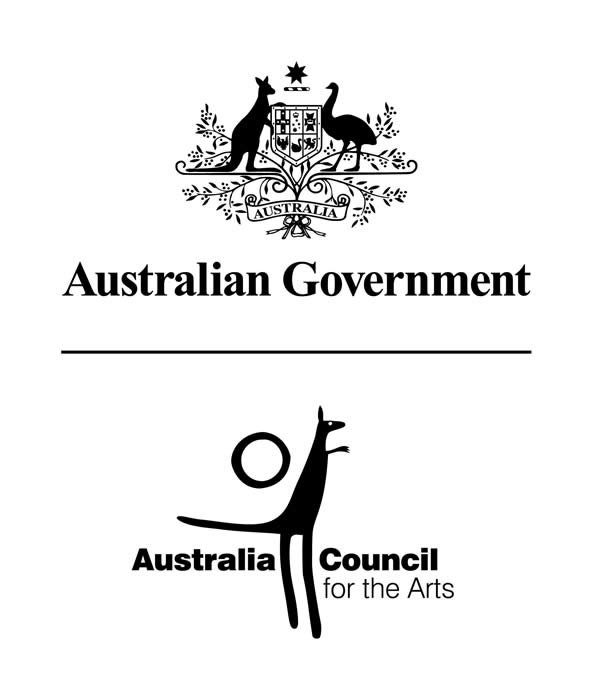From an Island South
Group Show
From an Island South is presented in partnership by Davenport Regional Gallery and the Asialink Centre of the University of Melbourne.
This marks the first partnership between the Devenport Regional Gallery and Asialink and is the only exhibition dedicated to Tasmania and its landscape that has been toured by Asialink in its 16 year history.
Tasmania is an island of extraordinary beauty which rests beneath the south eastern tip of mainland Australia. Vast tracts of the coastline remain wild and undeveloped, while the highland reaches are still eerily uninhabited. Headlands have been battered into shape by ferocious westerlies whose sheer relentlessness has stunted trees, suppressed grasses, and wrecked ships in terrifying numbers. The main cities are small and nestled in picturesque valleys with generous glimpses of mountains, rivers and beaches. Bushland is just beyond the suburbs and some of the world’s oldest surviving forests and most isolated beaches are barely an hour away by car. There is a sense of escape, exploration, and solitariness. Winter fog softens mountains peaks while low lying light casts long shadows from ancient trees. Stars shine crisply from the sky’s undisturbed blackness and, in summer, the Aurora Australis can be seen sweeping its pink, majestic pathway across the universe.
There is no doubt that this raw beauty has lured, inspired, enrapt, and obsessed artists since European occupation. However, the work of Tasmania’s contemporary landscape artists does not represent the sublime alone. As the artists in From an island south have immersed themselves within Tasmania, they have stumbled across the complexities underlying the island’s culture. Inevitably the artists have begun to breathe the politics, history and traditions of the island, aspects which have unavoidably found a way into their artwork. Each artist’s career has been established around Tasmania’s landscape and their own place within it. Whether they are Tasmanian by birth or by choice, the artists have used their art practice to develop and express a strong sense of Tasmania as home, and collectively their works tell an intriguing story of humankind’s relationship to the island.
The Drowned Series (2001-02) capture the lakes in Tasmania’s central and western districts which were dammed during the mid to late 1900s by the Hydro Electric Corporation. These lakes are primary examples of a wilderness which has been tamed and reshaped by humankind. They exist in an area little visited by locals or tourists despite the uniqueness of the surrounding world heritage listed forest and river systems for the terrain is steeps, densely treed, damp and notoriously difficult to access. Ironically, these ‘wilderness’ characteristics create the perfect place to establish controversial, large scale industrial projects.
Man’s manipulation of the natural environment is also the impetus behind Richard Wastell’s paintings, his recent imagery drawing from lakes similar to those visited by Stephenson, and the logged coups of old growth forest. Not far from here. Burnt mangerns and firebombed forest. Styx Valley (2005) exposes the chatted stumps of large manferns, their once upright posture twisted to suggest agony, emphasizing the naked absurdity of the blunt, frondless trunks. Yellow sunlight bakes the exposed ground for possibly the first time ever and fire blazes on the horizon creating ominous plumes of smoke. The scene is reminiscent of a moonscape and one senses Wastell is both bewildered and perversely fascinated by the transformed environment. The artist insists that this is not a political painting, but a raw and honest interpretation of the denuded forest – the newly emerging Tasmanian landscape.
In Not far from here the forest is devastated. The colours are hot and hyper-real – a world away from the gentle greys, greens and browns in Wastell’s other painting Last night I dreamed an island gentle (2003). In dramatic contrast, this image transports the viewer deep into the Tasmanian forest’s interior. The large trees emanate silent grandeur. One feels safely enveloped within the unseen canopy, immersed within some other world. Lichen spores float between the trees, creating a snow-like curtain. These spores are timeless, alluring but untouchable, hovering gently and confusing the viewer’s perception of space and distance. The painting provides a sense of shelter, a haven which embodies both the painter and the viewer. The artist’s intimacy with the Tasmanian bush is the foundation for these depictions of the environment. Ultimately, Last night I dreamed an island gentle establishes a grave context for the image of the burning coup. It is a heart wrenching testament to the vulnerability of the forest and its fragile place within Tasmania’s landscape.
Reclamation of indigenous language and relationship to place also underlies the collaboration between Aboriginal poet Jonathan Kimberley. During the past eighteen months, the two have made regular visits to Everett’s country in north east Tasmanian where they have observed the environment while camping. Each responds to the natural landscape with a combination of immediacy and contemplation. While in the bush, Everett records the thoughts that occur in response to the surrounding land and Kimberley paints directly onto the canvas. They rework the text and images on returning to the studio.
Everett and Kimberley refer to the outdoor aspect of the work as ‘bush painting’. They understand this process to be a collaboration with country, therefore investing the land with an interactive persona of its own. Everett’s presence is critical to Kimberley’s visual interpretation, and the indigenous approach to understanding the environment causes the painter to question western cultural perspectives. By employing a candid process reminiscent of the European tradition of plein air painting. Kimberley combines Aboriginal and western approaches to landscape to engender a uniquely personal response to place.
Everett’s poetry evokes visual responses related to his connection to this country. Ria-warrawah is the deep water spirit and the phrase ‘respecting moon water moving along coastal veins’ alludes evocatively to the visceral interchange between body and land, blood and water. His ancestral connection to this part of Tasmania is vital to the work produced in the collaboration with Kimberley. His words are warm and welcoming, inviting one to imagine free the place he writes about. When woven through Kimberley’s paintings, the result is a fresh, fluid, and balanced exchange of visual and textual imagery.
Ria-warrawah within all-life circuitry (2006) and Kimberley’s other painting, Shift: Cloudglyph 110 (2005), can be read from aerial and frontal perspectives. He follows the paths traveled by Aboriginal people and has loosely mapped the terrain from mountains to coast. However, the same lines that form the topographical image merge with the trunks and branches of trees. In each painting, Kimberley has built layer over layer, as if compelled to revisit the places he paints to record the various light and weather patterns, continuously building closer ties and understanding with place.
In From an Island south, the turbulent story of Tasmania’s European occupation is woven into images of the island’s highlands, forests, suburbs, bush, lakes, clouds and coast. Collectively, these artists illustrate aspects of the island’s way of life such as the fine line between city and bushland, the prominent position landscape holds in Tasmania’s contemporary art movement, the affinity these artists have with the landscape, the effects of industrial development, and the past and present relationship Tasmanian Aboriginal people hold with the land and its inhabitants.
Although Tasmania is the source upon which each artist’s work thrives, it might also be considered that the environment lives on in their work. Most importantly, it is a strong sense of place which compels each artist to make work about their homeland. They capture elements of a contemporaneous Tasmania and fix it in time, collectively creating a prism of responses from this unique southern island.
Extrated from catalogue jointly published by ASIALINK centre of the University of Melbourne and Devonport Regional Gallery





